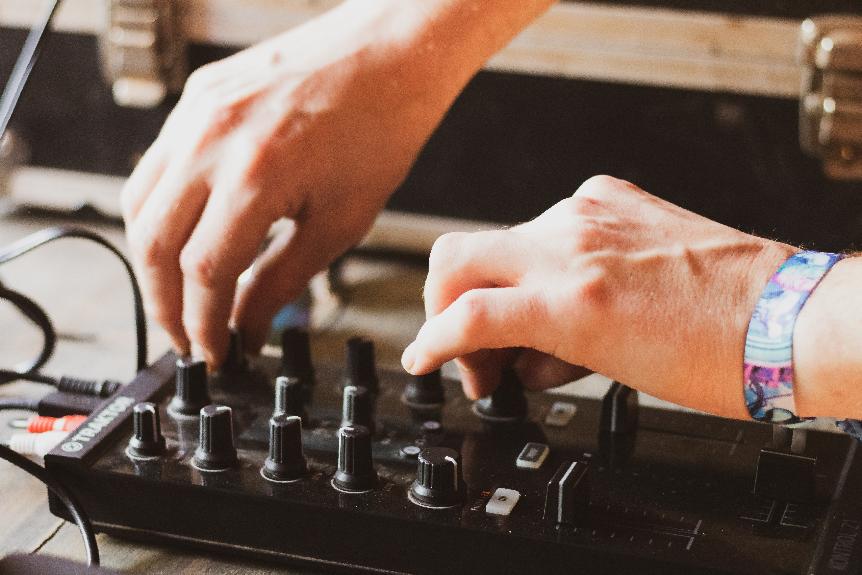No products in the cart.

Hey there! Ever wondered how to create those infectious, nostalgic beats of synthwave music? Look no further! In this article, I'll share my secrets on mastering the art of crafting synthwave tracks that will transport you straight to the neon-lit streets of the 1980s.
From the history of synthwave to the essential instruments and techniques, we'll dive deep into this captivating genre.
So grab your synthesizer, let's get grooving, and unlock the secrets of creating mesmerizing synthwave music!
The history of Synthwave traces back to the 1970s and 1980s when electronic music and synthesizers gained popularity in mainstream music. Synthwave is heavily influenced by the music of that era, particularly the soundtracks of iconic movies like Blade Runner and Tron. These films, with their futuristic settings and pulsating electronic scores, captured the imagination of a generation and laid the foundation for the Synthwave movement.
Today, modern Synthwave artists draw inspiration from these influences, but also add their own unique twist to the genre. They incorporate elements of modern electronic music, such as heavy basslines and intricate synth melodies, to create a sound that's both nostalgic and fresh. Some notable modern Synthwave artists include The Midnight, Gunship, and FM-84. Their music brings a modern sensibility to the retro sound, attracting a new wave of fans to the genre.
To create authentic Synthwave music, I rely on a set of essential instruments that capture the nostalgic and futuristic sounds of the genre.
Retro synthesizers are at the heart of Synthwave, providing the iconic tones that transport listeners back to the neon-lit streets of the 1980s. From the warm and lush pads to the catchy and melodic leads, these synthesizers are essential in creating the signature sound of Synthwave.
In addition to synthesizers, drum machines play a crucial role in shaping the rhythmic foundation of the genre. With their punchy and tight beats, drum machines provide the driving force behind Synthwave tracks, adding a sense of energy and groove.
Together, retro synthesizers and drum machines form the backbone of Synthwave music, allowing me to create immersive and nostalgic soundscapes that pay homage to the past while envisioning the future.
One essential step in mastering the art of creating Synthwave music is crafting catchy melodies. These melodies are what captivate the listeners and make them groove to the rhythm. To create atmospheric synthwave textures, it's crucial to incorporate analog synthesizers in your compositions. The warm and rich tones produced by these instruments add depth and nostalgia to your melodies.
Experimenting with different synthesizer sounds and effects can help you achieve the desired vibe. Remember to keep the melodies simple yet memorable, with catchy hooks and nostalgic flourishes. Utilize techniques like arpeggios, octave jumps, and melodic variations to keep the listener engaged.
Crafting catchy synthwave melodies is a skill that takes practice, but with dedication and experimentation, you can create captivating and unforgettable music.
When it comes to creating Synthwave music, I find that the key to achieving a retro-inspired sound lies in designing captivating and nostalgic synth tones. Retro aesthetics are at the heart of Synthwave, and sound design plays a crucial role in capturing that nostalgic vibe.
To achieve this, I employ various sound design techniques that transport listeners back to the 80s. One of my go-to techniques is using analog synthesizers to recreate the warm and rich tones of vintage hardware.
I also like to experiment with gated reverb effects, which were popular in the 80s and give the sounds a distinct and recognizable character. Additionally, I often incorporate arpeggiators and pulsating basslines to create that signature Synthwave sound.
For mixing and mastering Synthwave tracks, I rely on my knowledge and experience to achieve the perfect balance and polished sound.
One common mistake in Synthwave tracks is having an overcrowded mix, where too many elements are competing for attention. To avoid this, it's important to carefully choose which elements to prioritize and ensure they've enough space in the mix.
Another mistake is neglecting the low end. Synthwave tracks often rely on strong basslines, so it's crucial to pay attention to the low frequencies and make sure they're well-defined and present.
When it comes to mastering, techniques like EQ, compression, and limiting are used to enhance the overall sound and make it more cohesive. It's also important to consider the target platform and adjust the mastering accordingly to optimize the playback experience.
Having a deep understanding of music theory is not necessary to create synthwave music. While it can be helpful, creativity and experimentation are key. Focus on the nostalgic sounds, pulsating beats, and retro vibes to bring your synthwave tracks to life.
When designing retro-inspired synthwave sounds, it's important to avoid common mistakes that can diminish the authenticity and impact of your music. Here are some tips to create the perfect nostalgic vibes.
To make my synthwave tracks more authentic and nostalgic, I focus on creating a unique sound palette. Attention to detail is crucial in achieving that vintage feel. It's all about capturing the essence of the '80s.
There are several recommended plugins and essential software for creating synthwave music. These tools can enhance the nostalgic and authentic sound you're aiming for. Let's explore some options to take your tracks to the next level.
When exploring niche subgenres of synthwave, you'll discover a vast array of variations. From darksynth with its haunting melodies, to dreamwave with its ethereal sounds, each subgenre brings unique elements to create successful synthwave tracks.
